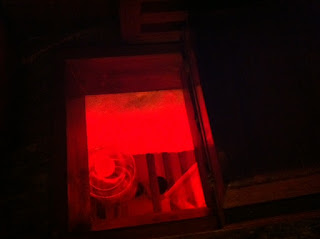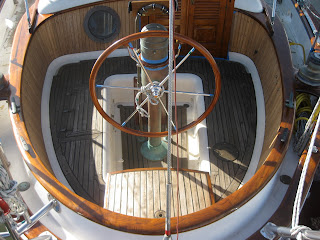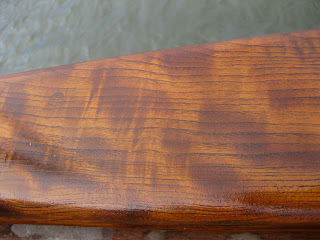After cleaning and repainting the engine, we finally got around to digging a little deeper in determining its current health. Our engine is a 1983 Mercedes 616 (same engine as on the 240D car) that's been marinized by Nanni, and it's got about 5900 hours on it so it's getting on in age. We were worried that it was on its way out, though other than our overheating issue, it's been running fine. So to get a better idea of the life that's left in it, we opted to do our own compression test.
 |
| Specially bent wrenches |
Before a compression test can be performed, it is required that the
 |
| In use |
valves be properly adjusted. Unfortunately, this required special wrenches that fit in the tight spaces. Mercedes and other companies make these special valve adjustment wrenches, but they go for over $100 a set. With a little heat, a pair of 14mm long handled wrenches, some silver solder, and scrap pieces of pipe, Frank was able to save us the money by bending us a set of our own. Times like this is when our workshop and it's built in vice really come into their own. Good thing we went through all of this as every one of the 8 valves were grossly out of spec. The adjustment was a fairly straight forward job and we replaced our valve cover gasket at the same time.

Then it was onto the compression test. We had bought a US General compression tester that had a special fitting that goes in place of the fuel injector; our results were: 380, 350, 390, 340 psi with a total of approximately 13% between all 4 cylinders. We were all smiles...why? Well in english, this means that the engine is in "Good-Excellent condition." A brand new Mercedes 616 engine would have a compression between 375-425. Also ideally, the difference in compression between each cylinder should be around 10%, so that was GREAT news. Not bad for a 28 year old engine with nearly 6000 hours that's the aprox equivalent of 295,000 miles. We had heard that the 616s can go for up to 10,000 hours before a rebuild, but we were skeptical until now. As a comparison, most Yanmars can get around 5000 hours before a rebuild.
 |
| Nice |
Lacking a terminal diagnosis, we decided it was time to go ahead and spruce our old lady up. Frank replaced all the fuel lines, 50 ft in total, labelled their shut off valves, installed dual in-line Raycor fuel filters, replaced all return lines, and installed a new/better designed lift pump. At the same time, he improved upon our engine access by cutting an inspection door into the back of our settee that covers the engine. He installed hinges that come apart so we can remove the entire door (I thought it was pretty clever). This allows us to change the oil, oil filters, fuel filters, and access the seacocks without having to move around our whole settee (very heavy!)
 |
| Before |
 |
| After |
 |
| Engine Access |
We are now waiting on a set of fuel injector nozzles and to run a diesel purge (which supposedly helps to break up carbon deposits in the cylinders). Next on our engine list is figuring out why all our coolant keeps disappearing. There is obviously a leak somewhere...one step at a time.
If all of this wasn't enough, while everything was already apart, we also replaced our refrigerator pump. It appeared to have been a cheap Home Depot-esque pump designed for fountains and landscaping water fixtures. As you can guess, it didn't hold up very well in our marine environment and was leaking from the body as well as growing us a beautiful salt sculpture. Though we can appreciate good art, artists don't make good pumps, so the lazy bastard had to go. We now have a proper March pump designed for our fridge in its place.





















































